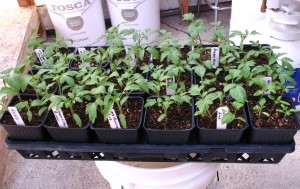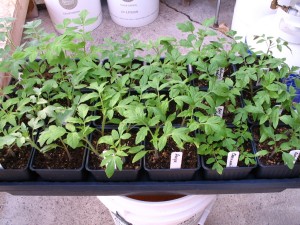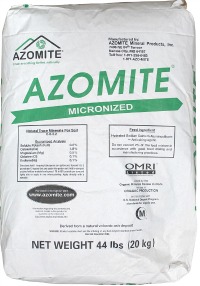Mineralization has arrived…in the form of Azomite!
Here are some results of planting in Azomite blended into my potting soils. Both trays of plants were transplanted on the same day. The first photo is (without) and the second was with Azomite. Can you tell if there is a difference??
Azomite is an acronym for the “A to Z of minerals including trace elements”.
Available in 2 forms (fine and granular) as a slow release, packaged in 44-pound bags.
Please call Mandy for pricing (1-204-268-3984) and pickup.
or email: mandy@mandysgreenhouse.com
AzomiteOre-CertificateofAnalysis1
From Wikipedia:
Azomite is a complex silica ore (hydrated sodium calcium aluminosilicate) with an elevated ratio of trace minerals unique to the Utah mineral deposit from which it is mined. When the ash from a volcanic eruption filled a nearby seabed an estimated 30 million years ago, the combination of seawater, fed by hundreds of mineral-rich rivers and the rare earth minerals present in the volcanic ash, created the deposit’s distinctive composition.
Scientific analysis of this combination of volcanic ash and marine minerals reports over 70 trace minerals, many recognized as essential by the National Research Council of Canada.[2] A typical analysis of an Azomite sample using spark source mass spectrometry reveals the presence of many rare earth elements.[3]
Azomite is added to compost or other fertilizer material and spread at the rate of 300 to 600 pounds per acre and either lightly disked into the soil surface of applied in the row when planting. For gardens, spread ¼ to 2 pounds per 10ft x 10ft and spade into the soil. Use 1 teaspoon or 1 cup in watering can quarterly for house plants. In feed rations, 1-2 percent (do not exceed 2 percent) of the feed mixture and mix thoroughly with feed.
AZOMITE ® Ore Certificate of Typical Analysis
ICP and Spark Source Mass Spectrometry
ppm unless shown as %
Aluminum 6.57% Hafnium 0.62 Ruthenium 0.01
Antimony 0.16 Holmium 0.60 Samarium 4.98
Arsenic 1.10 Hydrogen 0.38% Scandium 1.16
Barium 0.14% Indium 0.02 Selenium 0.29
Beryllium 0.51 Iodine 2.20 Silicon 30.68%
Bismuth 0.30 Iron 1.16% Silver 0.97
Boron 29.00 Lanthanum 21.05 Sodium 1.31%
Bromine 6.60 Lead 9.96 Strontium 66.34
Cadmium 0.07 Lithium 18.23 Sulfur 0.02
Calcium 2.84% Lutetium 0.30 Tantalum 1.30
Carbon 0.61% Magnesium 0.59% Tellurium 0.01
Cerium 41.27 Manganese 0.01% Terbium 0.51
Cesium 0.88 Mercury 0.02 Thallium 0.16
Chlorine 0.22% Molybdenum 0.23 Thorium 7.51
Chromium 3.82 Neodymium 33.61 Thulium 0.28
Cobalt 1.54 Nickel 1.66 Tin 0.98
Copper 2.85 Niobium 0.18 Titanium 0.14%
Dysprosium 2.95 Nitrogen 0.15% Tungsten 0.30
Erbium 1.73 Palladium 0.01 Uranium 0.58
Europium 1.03 Phosphorus 0.02% Vanadium 14.12
Fluorine 900.00 Potassium 4.19% Ytterbium 1.86
Gadolinium 3.60 Praseodymium 10.31 Yttrium 6.23
Gallium 3.01 Rhenium 0.01 Zinc 12.71
Germanium 0.09 Rhodium 0.00 Zirconium 24.68
Gold <0.2 Rubidium 24.41 Loss on incineration 8.06%
Guaranteed Minimum Analysis
Soluble Potassium
Calcium
Sodium
Magnesium
Soluble Magnesium
Soil Application Guidelines
AZOMITE® will not harm or burn plants. Apply directly or with compost, humus, manures, fertilizers, beneficial soil microbials. May be used in compost tea productions.
Field Crops Apply 75 –150 lbs. per acre initially followed by annual maintenance of 50 –100 lbs. per acre or according to needs based on soil quality.
Citrus/Fruit/Vines Apply annually to all trees on ground surface under the drip line at the rate of 1 to 5 pounds, depending on the tree size. (Refer to table above for more guidelines.) Double the application for decline or blight stricken trees. For grapes, apply 1⁄2 lb. to 1 lb. to the soil around each plant and lightly till into soil.
Flowers/Plants/Vegetables When preparing the soil, use AZOMITE® at the rate of 1 lb. per 10 sq. ft. If in rows, mix into the soil along the rows at rate of 1 lb. per 25 ft. of row. If bed is established, sprinkle around each plant. For houseplants, mix 1 teaspoon per 2-inch pot diameter with potting soil before planting. Give 1 teaspoon quarterly thereafter. For roses, apply 1/2lb. to 1 lb. to the soil around each plant and lightly till into soil.
Lawn/Turf Care For existing lawns, a 44 pound bag will cover 12,000 to 15,000 square feet. Apply up to 4 times per year. For new lawns, apply at a heavier rate and till into soil before planting seed or laying sod.
Ornamentals/Shrubs/Trees Apply annually to all trees on ground surface under the drip line. Recommended application for trees:
Tree Base Diameter < 10” – Rate 1 –5 lbs. Diameter 10” –20” – Rate 5 –15 lbs. Diameter > 20” – Rate 15 –40 lbs. Apply light coating from trunk to drip line. For ornamentals and shrubs, apply 1⁄2 lb. to 1 lb. to the soil around each plant and lightly till into soil.
Primary Trace Minerals and Rare Earth Elements in AZOMITE®
Rare Earth Elements
Typical analysis reports the presence of Lanthanum (La), Cerium (Ce) and Praseodymium (Pr) in AZOMITE® at 644 ppm
1. Confirmed in greenhouse and field conditions to increase crop yields up to 15% in some plant species,
particularly if moisture was limiting.
2. Rare Earth Elements may enhance nitrogen fixation by Azotobacter species
3. Rare Earth Elements may enhance absorption of ions by root hairs
4. Rare Earth Elements may enhance manganese and iron absorption
5. Rare Earth Elements may enhance Photosystems I & II efficiencies
6. Rare Earth Elements have enhanced abscissic acid production
7. Rare Earth Elements have been shown to help plants contend with stress
8. Rare Earth Elements may stimulate Mg-ATPase in photosynthesis
9. Rare Earth Elements enhance the Hill Rxt of Photosynthesis
10. Rare Earth Elements have inhibited fungal growth (Cercospora nicotianae)
Zinc (Zn) A typical analysis reports 64.3 ppm. Zinc is essential for many different enzyme systems in plants. Zinc is important for synthesizing nucleic acids. Zinc is utilized in metabolizing the hormone Auxin.
Boron (B) A typical analysis reports 29 ppm. Has a role in biosynthesis. Impacts metabolic pathways. Improves plasma membrane integrity. Impacts the uptake of sugar.
Copper (Cu) A typical analysis reports 13.5 ppm. Enzyme activator, notably nitrogen reductase, and for certain protein forming and Vitamin A forming enzymes; an essential part of photosynthesis.
Cobalt (Co) A typical analysis reports 22.3 ppm. Root nodule bacteria is required to fix nitrogen and therefore the presence or absence of Co has a direct bearing on legume plants. Enzyme activator, helps form vitamin B12; improves growth, water movement and photosynthesis; boll production in cotton.
Iodine (I) A typical analysis reports 3.2 ppm. Some chemical forms of iodine appear to stimulate various plants. For example iodate, not iodide, stimulates the growth of a wide range of plants.
Manganese (Mn) A typical analysis reports 200 ppm. Manganese is involved in activating several enzyme systems, photosynthesis and protein synthesis
Molybdenum (Mo) A typical analysis reports12.6 ppm. Necessary for nitrogen fixation. Used by the enzyme systems nitrogenase and nitrate reductase. Involved in nitrogen metabolism; similarly stimulates plant vigor. An important part of chlorophyll. Essential for iron and phosphate metabolism
Nickel (Ni) A typical analysis reports 2.6 ppm. The most recent element added to the essential trace element list. Pecans are among plants known to require Ni for fruit production.
Arsenic (As) A typical analysis reports 1.1 ppm. At very low concentrations, it has has been known to stimulate plant growth. At high concentrations it is toxic to plants.
Selenium (Se) A typical analysis reports 0.79 ppm. Selenium is essential for animals and for bacteria, including the nitrogen-fixing bacteria. Essentiality in higher plants is controversial.
Tin (Sn) A typical analysis reports 2.9 ppm. Inorganic tin is generally unavailable to plants, absorbed by root hairs and generally not redistributed elsewhere in the plant. Conclusive studies have not been made.
Vanadium (V) A typical analysis reports 7.8 ppm. Essential for the formation of chlorophyll in several forms of algae (lower plants). Its role in higher plants is not yet clear.
Tungsten (W) A typical analysis reports 26 ppm. Tungsten interacts with molybedum and at < 5 ppm W has been reported to have a positive impact on a variety of higher plants.




Comments are disabled for this post